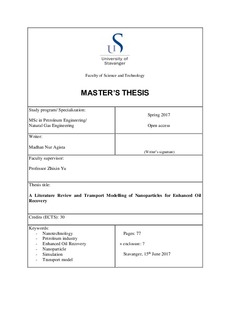| dc.contributor.advisor | Yu, Zhixin | |
| dc.contributor.author | Agista, Madhan Nur | |
| dc.date.accessioned | 2017-11-01T11:43:39Z | |
| dc.date.available | 2017-11-01T11:43:39Z | |
| dc.date.issued | 2017-06-15 | |
| dc.identifier.uri | http://hdl.handle.net/11250/2463419 | |
| dc.description | Master's thesis in Petroleum engineering | nb_NO |
| dc.description.abstract | Nanotechnology has been envisioned to transform every sector of industries, particularly in the petroleum industry. Numerous researches, especially on nano-EOR, have been done in the past few years and shown promising results for improving oil recovery. Injected nanoparticles (NPs) are believed to be able to form adsorption layers on the top of grain surface. The adsorptions layers then alter the wettability of the rock and reduce the interfacial tension. Due to the importance of the adsorption, numerous theoretical studies were performed to simulate the transport behavior of NPs in the porous media.
The purpose of this thesis is to i) review the state-of-the-art progress of nanoparticles application in the petroleum industry especially in EOR, and ii) simulate the transport and adsorption of nanoparticles in the porous media.
Literatures show that various types of nanoparticles can improve oil recovery through several mechanisms such as wettability alteration, interfacial tension reduction, disjoining pressure and mobility control. Parameters such as salinity, temperature, size, and concentration are substantial for nano-EOR. Several experiments indicate that NPs can improve the oil recovery significantly up to 20% after the primary recovery period.
Classical Advection-Dispersion Equation (ADE) is commonly used to simulate particles flow in the porous media, but it fails to simulate NPs flow due to the adsorption that occurs. The colloidal filtration theory (CFT) is used in the study to accommodate the adsorption. Several modifications on CFT, such as dual site model (ISTM), increase the number of unknown variables that reduce the efficiency and the accuracy of the model. Therefore, a simple modified linear adsorption model (ML) is proposed by the author, followed by parameter sensitivity study to reduce the unknown parameters and understand each parameter affecting on the model.
The simulation result indicates that CFT model is unable to predict the effluent history data. Differently, ML model demonstrates that it can predict the effluent history quite well. The comparison with ISTM indicates that both can simulate the behavior of NPs, and our ML model gives slightly better result than ISTM model. Therefore, the transport and adsorption of NPs can be predicted by the simple linear adsorption model. | nb_NO |
| dc.language.iso | eng | nb_NO |
| dc.publisher | University of Stavanger, Norway | nb_NO |
| dc.relation.ispartofseries | Masteroppgave/UIS-TN-IPT/2017; | |
| dc.rights | Navngivelse 4.0 Internasjonal | * |
| dc.rights.uri | http://creativecommons.org/licenses/by/4.0/deed.no | * |
| dc.subject | petroleumsteknologi | nb_NO |
| dc.subject | petroleum engineering | nb_NO |
| dc.subject | nanotechnology | nb_NO |
| dc.subject | petroleum industry | nb_NO |
| dc.subject | enhanced oil recovery | nb_NO |
| dc.subject | nanoparticle | nb_NO |
| dc.subject | simulation | nb_NO |
| dc.subject | transport model | nb_NO |
| dc.subject | reservoarteknologi | nb_NO |
| dc.subject | produksjonsteknologi | nb_NO |
| dc.subject | nanoteknologi | nb_NO |
| dc.title | A Literature Review and Transport Modelling of Nanoparticles for Enhanced Oil Recovery | nb_NO |
| dc.type | Master thesis | nb_NO |
| dc.subject.nsi | VDP::Teknologi: 500::Berg‑ og petroleumsfag: 510::Petroleumsteknologi: 512 | nb_NO |

